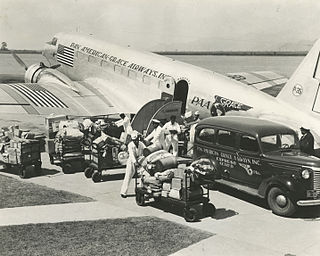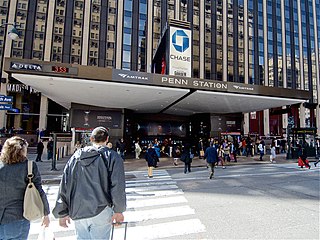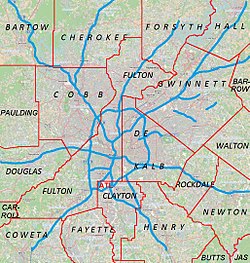
The Convair 880 is an American narrow-body jet airliner produced by the Convair division of General Dynamics. It was designed to compete with the Boeing 707 and Douglas DC-8 by being smaller but faster, a niche that failed to create demand. When it was first introduced, some in aviation circles claimed that at 615 mph (990 km/h), it was the fastest jet transport in the world. Only 65 Convair 880s were produced over the lifetime of the production run from 1959 to 1962, and General Dynamics eventually withdrew from the airliner market after considering the 880 project a failure. The Convair 990 Coronado was a stretched and faster variant of the 880.
This is a list of aviation-related events from 1980.

Lubbock Preston Smith International Airport is five miles north of Lubbock, in Lubbock County, Texas, United States. Originally Lubbock International Airport, it was renamed in 2004 for former Texas governor Preston E. Smith, an alumnus of Texas Tech University.

The BAC One-Eleven was an early jet airliner produced by the British Aircraft Corporation (BAC). Originally conceived by Hunting Aircraft as a 30-seat jet, before its merger into BAC in 1960, it was launched as an 80-seat airliner with a British United Airways order on 9 May 1961. The prototype conducted its maiden flight on 20 August 1963, and it was first delivered to its launch customer on 22 January 1965. The 119-seat, stretched 500 series was introduced in 1967. Total production amounted to 244 until 1982 in the United Kingdom and between 1982 and 1989 in Romania where nine Rombac One-Eleven were licence-built by Romaero.

Braniff Airways, Inc., operated as Braniff International Airways from 1948 until 1965, and then Braniff International from 1965 until air operations ceased, was an airline in the United States that once flew air carrier operations from 1928 until 1982 and continues today as a retailer, hotelier, travel service and branding and licensing company, administering the former airline's employee pass program and other airline administrative duties. Braniff's routes were primarily in the midwestern and southwestern United States, Mexico, Central America, and South America. In the late 1970s it expanded to Asia and Europe. The airline ceased air carrier operations in May 1982 because of high fuel prices, credit card interest rates and extreme competition from the large trunk carriers and the new airline startups created by the Airline Deregulation Act of December 1978. Two later airlines used the Braniff name: the Hyatt Hotels-backed Braniff, Inc. in 1983–89, and Braniff International Airlines, Inc. in 1991–92.

The NAMC YS-11 is a turboprop airliner designed and built by the Nihon Aircraft Manufacturing Corporation (NAMC), a Japanese consortium. It was the only post-war airliner to be wholly designed and manufactured in Japan until the development of the Mitsubishi SpaceJet during the 2010s, roughly 50 years later.

The Douglas DC-6 is a piston-powered airliner and cargo aircraft built by the Douglas Aircraft Company from 1946 to 1958. Originally intended as a military transport near the end of World War II, Douglas reworked it after the war to compete with the Lockheed Constellation in the long-range commercial transport market. Douglas built over 700, and many still fly in cargo, military, and wildfire control roles.

Pan American-Grace Airways, also known as Panagra, and dubbed "The World's Friendliest Airline" was an airline formed as a joint venture between Pan American World Airways and Grace Shipping Company. On September 13, 1928, a small single-engine Fairchild airliner flew from Lima, Peru, to Talara, Peru, which marked not only the beginning of Pan American Grace Airways but also the inauguration of scheduled air transportation along the West Coast of South America. From this short flight in 1928 to nonstop flights from New York to South America with Douglas DC-8 Intercontinental Jets in 1966, Panagra became the standard-bearer for transportation between the US Mainland East Coast and the West Coast of South America for 39 years. The "World's Friendliest Airline" merged with Braniff International Airways in 1967, and the combined carrier became the largest US airline serving South America.

Fort Smith Regional Airport is a public use joint civil–military airport located near the Interstate 540 freeway three nautical miles (6 km) southeast of the central business district of Fort Smith, in Sebastian County, Arkansas, United States. FSM is governed by the Fort Smith Airport Commission as established by the City of Fort Smith, Arkansas. It serves the transportation needs of residents and businesses of western Arkansas and eastern Oklahoma. FSM is currently served by American Eagle, the regional airline affiliate of American Airlines. It has a large population of corporate and general aviation aircraft. A full-service fixed-base operator (FBO), Signature Flight Support, provides service to general aviation, airline, and military operators.

Tupelo Regional Airport is a public use airport located 3.7 miles; 3.2 nautical miles (6 km) west of the central business district of Tupelo, a city in Lee County, Mississippi, United States. It is owned by the Tupelo Airport Authority. The airport is mostly used for general aviation, but is also served by one commercial airline with scheduled passenger service subsidized by the federal Essential Air Service (EAS) program. Many college football teams visiting the University of Mississippi, 49 miles west in Oxford, fly into Tupelo.

Brownsville/South Padre Island International Airport is 5 miles east of downtown Brownsville, Cameron County, Texas.

The Delta Flight Museum is an aviation and corporate museum located in Atlanta, Georgia, United States, near the airline's main hub, Hartsfield–Jackson Atlanta International Airport. The museum is housed in two 1940s-era Delta Air Lines aircraft hangars at Delta's headquarters, designated a Historic Aerospace Site in 2011. Its mission is to allow visitors from around the world "to explore aviation history, celebrate the story and people of Delta, and discover the future of flight." Over 40 airlines in Delta's family tree can be found in the museum's collections and exhibitions. The museum is a nonprofit organization and relies on volunteers, corporate sponsors, donations, event rentals and merchandise sales. The Delta Flight Museum is considered an ongoing project and items are added to the collections year round.

The Martin 4-0-4 was an American pressurized passenger airliner built by the Glenn L. Martin Company. In addition to airline use initially in the United States, it was used by the United States Coast Guard and United States Navy as the RM-1G.

Topeka Regional Airport, formerly known as Forbes Field, is a joint civil-military public airport owned by the Metropolitan Topeka Airport Authority in Shawnee County, Kansas, seven miles south of downtown Topeka, the capital city of Kansas. The National Plan of Integrated Airport Systems for 2011–2015 called it a general aviation airport.

The Sullenberger Aviation Museum formerly the Carolinas Aviation Museum, is an aviation museum on the grounds of Charlotte Douglas International Airport in Charlotte, North Carolina.

Mid-Continent Airlines was an airline which operated in the central United States from the 1930s until 1952 when it was acquired by and merged with Braniff International Airways. Mid-Continent Airlines was originally founded as a flight school at Rickenbacker Airport in Sioux City, Iowa, during 1928, by Arthur Hanford Jr., a dairy operator. The Hanford Produce Company was the largest creamery in the United States with over 100 trucks in operation. The company was primarily a dairy but also sold ice cream and poultry. The Hanford's also founded and built the new Rickenbacker Airport and operated eight gas stations and several service repair garages under the name Hanford's, Inc. The airport was a division of Hanford's, Inc., but the service stations and garages were later sold to finance airline operations. Mid-Continent was based in Kansas City, Missouri at the time of its acquisition by Braniff.

The Boeing 747SP is a shortened version of the Boeing 747 wide-body airliner, designed for a longer range. Boeing needed a smaller aircraft to compete with the McDonnell Douglas DC-10 and Lockheed L-1011 TriStar tri-jet wide-bodies, introduced in 1971/1972. Pan Am requested a 747-100 derivative to fly between New York and the Middle East, a request also shared by Iran Air, and the first order came from Pan Am in 1973.

A transport hub is a place where passengers and cargo are exchanged between vehicles and/or between transport modes. Public transport hubs include railway stations, rapid transit stations, bus stops, tram stops, airports and ferry slips. Freight hubs include classification yards, airports, seaports and truck terminals, or combinations of these. For private transport by car, the parking lot functions as a unimodal hub.

The American Airlines C.R. Smith Museum (CRSM) is located on the campus of the American Airlines Flight Academy, which is situated at the southern end of DFW Airport, in the city limits of Fort Worth, Texas, and in close proximity to the world headquarters of American Airlines. The location is at the midpoint between Downtown Dallas and Downtown Fort Worth near the intersection of Highways 183 and 360. The CRSM has an exhibit gallery of approximately 25,000 square feet (2,300 m2) and a 10,000-square-foot (930 m2) hangar that houses the Flagship Knoxville, a fully restored DC-3 aircraft. The museum also includes a 1,500-square-foot (140 m2) gift shop and a large-format theatre similar to IMAX.
Universal Aviation Corporation was an airline holding company based in United States.



















